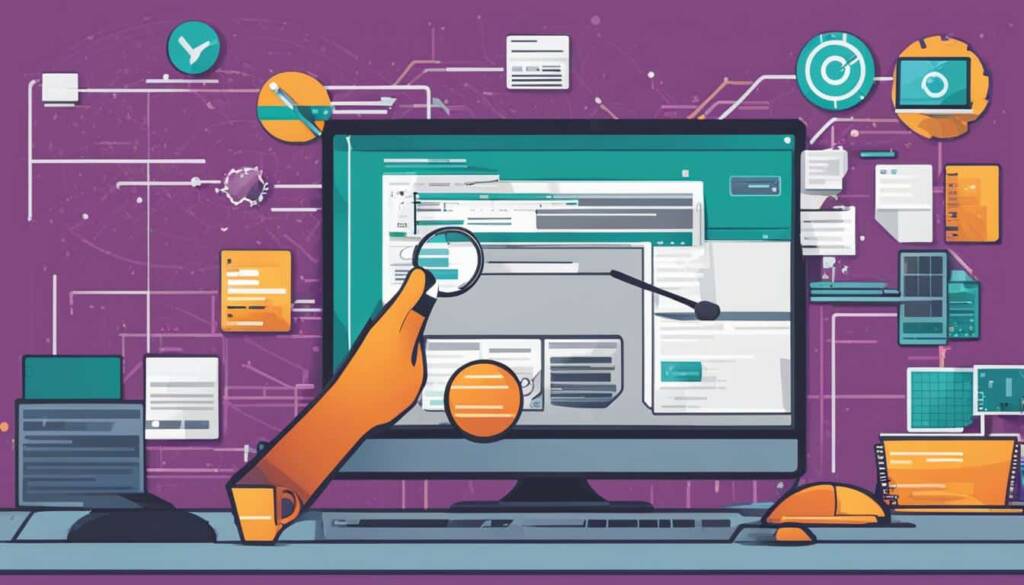Table of Contents
Debugging is a critical aspect of software development. It involves the process of finding and fixing errors or bugs in code to ensure that the program runs smoothly. Debugging helps developers identify and resolve issues, improving the overall functionality and performance of the software.
By understanding the concept of debugging and implementing efficient debugging techniques, developers can streamline the development process and deliver high-quality software. Software errors can disrupt the normal flow of a program, causing it to crash or produce incorrect results. Identifying and resolving these errors is crucial for creating reliable and user-friendly software.
Effective debugging requires a systematic approach to problem-solving. Developers need to analyze the code and its execution to pinpoint the source of the error. This process involves examining error messages, using search engines like Google for solutions, and applying logical reasoning to isolate the problem. Seeking help from online communities or colleagues can also be beneficial in resolving complex issues.
Furthermore, writing clean and well-structured code can significantly reduce the occurrence of bugs. Following best practices and employing coding standards can make the code more readable and easier to debug. This helps in quickly identifying and resolving errors, resulting in efficient debugging and higher productivity.
Overall, debugging plays a vital role in software development by ensuring the smooth operation of programs and improving the quality of the final product. The ability to identify and resolve software errors is a valuable skill for developers, enabling them to create reliable and robust software solutions.
The Importance of Debugging in Software Development
Debugging plays a vital role in the field of software development, primarily due to its abstract and conceptual nature. In programming, developers work with complex codes and manipulate abstract concepts to create functional software. However, this abstract activity often leads to the emergence of software bugs and programming errors. This is where debugging comes into the picture.
Debugging is the process of identifying and resolving software bugs and programming errors in code. It allows developers to pinpoint the root cause of these issues and take the necessary steps to correct or address them. By actively engaging in the debugging process, developers can ensure that their software performs as expected and delivers the desired outcomes.
One of the key reasons why debugging is essential is its close association with the software testing process. Testing is an integral part of software development that aims to assess the functionality, performance, and reliability of the software. Without proper debugging, software testing becomes challenging, as unresolved bugs and errors can affect the outcome of the testing phase.
By debugging their code effectively, developers can save a significant amount of time and effort in the long run. Debugging allows for the identification and resolution of errors early in the development process, which helps prevent these issues from persisting throughout the project lifecycle. This not only enhances the overall quality of the software but also eliminates potential setbacks and delays during deployment.
To illustrate the importance of debugging further, consider a scenario where a software product is released without undergoing robust debugging. In such cases, users may encounter various issues, ranging from crashes and malfunctions to data corruption. These problems can lead to negative user experiences, loss of trust, and damage to the reputation of the software developer or organization.
Image:
Therefore, debugging serves as a critical component in the software development process, ensuring the creation of reliable and high-performing software. It helps developers identify and rectify errors, thereby contributing to the overall success of the software project.
Effective Debugging Techniques
When encountering errors in their code, developers can utilize effective debugging techniques to efficiently identify and resolve issues. The following techniques can be applied to streamline the debugging process:
- Error Messages: Pay close attention to error messages provided by the development environment or programming language. These messages often provide valuable clues about the specific issue at hand. By carefully analyzing and understanding these error messages, developers can quickly pinpoint the source of the problem.
- Google Search: When faced with a challenging bug or unfamiliar error, developers can turn to Google for assistance. The vast amount of resources available online can provide insights and solutions to common coding issues. By searching for the specific error message or related keywords, developers can often find helpful discussions, forums, or stack overflow threads where others have encountered and resolved similar problems.
- Logic Explanation: Take a step back and carefully analyze the logical flow of the code. By mentally tracing the execution path, developers can identify potential areas where the bug might exist. This technique involves understanding the expected behavior and comparing it to the actual behavior exhibited by the code. By isolating the discrepancy, developers can narrow down the potential sources of the error.
- Problem Isolation: Break down the problem into smaller components or sections of code. By systematically disabling or selectively running specific parts of the code, developers can isolate the portion responsible for the error. This technique helps narrow down the scope of investigation, making it easier to identify the root cause of the problem.
- Seeking Help: Don’t be afraid to seek help from colleagues or online communities. Collaborating with other developers can lead to fresh perspectives and alternative approaches to solving the problem. Sharing the code, error messages, and a clear explanation of the issue can aid in obtaining accurate guidance and suggestions.
- Clean Code Writing: Writing clean and organized code can significantly reduce the occurrence of bugs and make debugging more efficient. Utilize proper coding conventions, meaningful variable names, and appropriate comments to enhance code readability. Well-structured code is easier to understand and debug, saving valuable time and effort.
By employing these effective debugging techniques, developers can navigate through software errors with greater ease and efficiency, ensuring the development process remains smooth and the final product is robust and reliable.
Debugging Tools and Resources
Developers have access to a variety of useful debugging tools and resources that can greatly assist in the debugging process. These tools are designed to enhance the efficiency and effectiveness of debugging, helping developers identify and resolve software errors more swiftly and accurately.
One commonly used tool is the Integrated Development Environment (IDE), such as Visual Studio Debugger. IDEs provide a comprehensive set of features specifically designed for debugging, including breakpoints, step-by-step execution, variable inspection, and more. These features enable developers to closely analyze the code execution and pinpoint any issues.
Another valuable tool is the console.log function, which allows developers to print out specific values or messages to the console during execution. This can be helpful in understanding the flow of the code and identifying problematic areas. By strategically placing console.log statements throughout the code, developers can gain valuable insights and track down bugs more efficiently.
Additionally, debugging tools provided by web browsers, such as the Chrome Debugger, offer powerful debugging capabilities for web development projects. These tools enable developers to inspect and modify the HTML, CSS, and JavaScript of a web page in real-time, making it easier to identify and fix issues directly within the browser environment.
By leveraging these debugging tools and resources, developers can streamline their debugging process and accelerate the bug-fixing phase of software development. With a combination of powerful IDEs, console.log statements, and web browser debugging tools like Chrome Debugger, developers can identify and resolve software bugs with efficiency and precision.
FAQ
What is debugging in coding?
Debugging in coding involves finding and fixing errors or bugs in the code to ensure the smooth running of a program.
Why is debugging important in software development?
Debugging is crucial in software development because programming involves working with abstract concepts, which often leads to errors and bugs. By debugging, developers can identify and rectify these issues, improving the overall functionality and performance of the software.
What are some effective debugging techniques?
Effective debugging techniques include analyzing error messages, conducting Google searches for solutions, providing logic explanations for code problems, isolating the issue, seeking help from colleagues or online communities, and writing clean code.
What debugging tools and resources are available for developers?
Developers have access to a range of debugging tools and resources such as Integrated Development Environments (IDEs), console.log statements for debugging in JavaScript, the Visual Studio Debugger for Microsoft applications, and the Chrome Debugger for debugging web applications.












